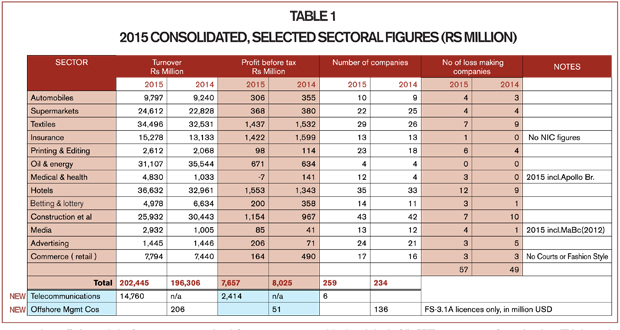Publicité
A flaccid year, lost
Par
Partager cet article
A flaccid year, lost

This paper was published as foreword to the 2016 edition of Business Publications’ “Top 100 Companies”. Philippe A. Forget, Executive Chairman of La Sentinelle Group, says that it is largely the health metrics of companies that fuel the macroeconomic statistics of the country.
Last year, round about this time, we were, most of us, still under the spell of the promises of Minister Luchmeenaraidoo’s first budget. An “economic miracle” had been predicted in March, with growth rates in the range of 5.3% to June 2016 and 5.7% to June 2017. However, by June 2015, the doubts were already worming their way through and in this very publication, I had asked: “What does the Minister know that we do not?” and commented on the Minister’s hard sell of smart cities (“We have completed the 8 smart city projects. It is done! And there are 7 new projects! On top of that we have the port… We will realise, as from September 2015, how solidly investments will accelerate,” he had declared) as a “brave and definitive statement that leaves little leeway for an explanation if things do not actually pan out.”
Pan out, they did not.
The smart cities that got going were all reconversions of existing projects (Medine, Azuri, Omnicane, Cap Tamarin…) and the port development of immense promise is still, to date, stuck in the starting blocks – with an emphasis on the word “blocks” rather than “starting”. As a result, GDP growth estimates were a tepid 3.1% for 2015. True enough, some countries would kill for this growth rate! However, in view of our ambitions of reaching “high income” status, we do need to do far better and this will entail far more hard work and stronger focus on what works in a developing economy.
The least one can say is that the last year has been a flaccid one. The notable exception has been tourism, where a bouquet of initiatives ranging from more open skies (Turkish Airlines, Air Asia, Austrian, new capacity on Emirates flights…) to more aggressive advertising (we are even on CNN, though we seem to have cold shouldered the “C’est un Plaisir” buttonhole…) have given new life to tourist arrivals (+ 10.9% over the previous year) and thence to higher hotel occupation rates, as hotel building licences themselves were restricted. However, the EPZ sector showed negative growth (minus 1.4%) and so did the sugar industry sector (minus 8.5%). The investment growth rate was a worryingly negative -5.2%, this negative trend showing up for the 5th year running, such that the investment rate as a percentage of GDP was down to a quite shoddy 17.7%. Unemployment, surprisingly, stayed stuck within the 7.8 to 8.0% parenthesis of the last five years.
The other unequivocal policy success of the year is to the credit of the Central bank which reacted promptly to protect the exporting industries’ competitiveness in the wake of a faltering euro. This eventually worked well, since there was a welcome and lucky margin of manoeuvre in the form of an across-the-board fall of commodity and petrol prices cushioning the imported inflation that should normally have followed a rupee adjustment that left the dollar more expensive by 15%, year on year. The signature of a revamped Double Taxation Agreement with India signaled the end of the status quo and the uncertainty linked to it, and even promises a “surge” of business up to April 2017, as investors may wish to exploit the grandfathering clause within the treaty. An Indian “gift” of Rs12.7 Bn in the same week as the modified DTA was signed inevitably led to the conclusion that one had been traded in for the other. In any case, Rs12.7 Bn is no mean sum and, if properly invested, can be useful indeed for government’s next budget, constrained as it is by the debt/GDP ratio which is currently well beyond 60% and offers little leeway going forward, as it needs to be reduced to 50% by 2018. I subscribe to the proposal that world-class infrastructure engenders meaningful investment downstream. The million -dollar question is: which infrastructures should we go for? One thinks road decongestion, new public transport, Internet connections improved to a guaranteed10 Mbps (more?) for individuals and 100 Mbps for all businesses, world-class PISAmonitored education, a better water service, an expanded, more efficient port of course, before one considers a grand new Heritage City for party posterity purposes.
The TOP 100 figures published for 2015 go more than some way to illustrate a flaccid year. Indeed, lest one forgets: it is largely the health metrics of companies that fuel our macroeconomic statistics and there is no better elixir for triggering investment than the stimulus of profits themselves!
One glaring feature of this year’s stock of results is that fully 28 companies of our top 100 had a lower turnover year on year. A further 21 had turnover growth rates which can be characterised as meagre to weak, of less than 6%. When close to 50% of your top 100 companies have growth rates of this order, one could easily submit that this is the sort of stuff that does not fuel much of a “feel good factor”. These figures can be explained partly by the fall in commodity prices (namely for wholesale importers, petrol majors…) but the construction industry got squeezed a little more, yet again (Sectoral turnover- Table I - down by fully 15%!). And surprisingly, there were even signs of consumption being stalled (FAIL, TNS Tobacco, Innodis, Edendale, Toyota, Ramdenee Group, J. Li Wan Po, Moroil, Meaders Feeds, Li Wan Po & Co, Shoprite, Yip Tong & Sons, Lai Fat Fur Bros, Sik Yuen Ltd, Lolo Supermarket, even Brinks…), in spite of a collapse of expenditure in the lottery and gaming industry (Lottotech, Play on Line, etc.) which should have freed funds for more tangible consumption. On a consolidated basis, over our sample Top 100 companies, turnover expanded by just under 5%. Over the expanded sample of 259 companies covering 13 selected sectors (Table I), turnover growth is an even weaker… 3.1%.

The other major conclusions flowing out of Table I are that:
(i) the percentage of loss-making companies out of our enlarged sample of 259 companies crept up to 22% and that
(ii) consolidated profits generated are down by close to 5%, such that, year on year, PBT as a percentage of turnover is down by 0.3%
The banking sector, still overwhelmingly dominated by MCB, had a reasonably stable year overall but showed some pretty material swings for individual companies. Thus, SBM’s profits were down for the second year running as provisions on various loans (of which BAI) and a major ICT project (project Flamingo) bit really hard into operating results, AfrAsia Bank had an annus horribilis after investments in Zimbabwe went belly up, Standard Chartered also had a bad year and HSBC showed more signs of retrenchment with total assets down by some 25% and profits down by 16%. MCB, Barclays, Investec, Standard Bank took up the slack. The impact that the new DTAA with India will have on the banking sector is being watched closely, but is unlikely to influence in any major way, just yet. The remarkable lack of financial openness of individual management companies within the offshore sector needs here to be highlighted and strongly questioned. Consolidated figures published by the FSC are summarised in Table I.
The remarkable profitability levels of the Civil Service Mutual Aid Association find an explanation in comfortable capitalisation levels, some leverage beyond the deposit base (deposits of some Rs24 Bn underpinning some Rs32 Bn in loans) and almost no impairment on financial assets, presumably on the basis that most borrowers have stable revenues through holding jobs for life.
Other features of the2015 Top 100 survey that require highlighting are the positive swing of fortune of Air Mauritius which puts it at the top of the “Profit difference” table (+Rs1.6Bn y/y), the 55% increase in turnover of Princes Tuna, the low profitability (and thence the high potential for improvement) of Pick n Buy, the very strong profitability of SICOM (22% on turnover) within the insurance sector (captive government business?) and the top spot of Bhunjun & Sons, turnover-wise in the construction sector.
The next budget is being earmarked for July and gives the new Minister of Finance, Pravind Jugnauth, a crucial opportunity to do what is right for the nation. Too often in the past, budget exercises have been rather futile in that instead of striking bold, decisive, reformist stances which stimulate and inspire, they end up spreading themselves thinly and incoherently in what has been endearingly described as “confetti budgeting”.
Some very real issues need to be tackled frontally however, and sooner rather than later. This is not the place for a detailed review, but we must note that having been recently lucky overall balance-of-payments-wise, there may soon come a time where a combination of factors (law & order, poor Internet bandwidth, deteriorating governance, National debt levels, for example) curtail fund flows from overseas (namely in the form of FDI) and thus lead to our basic current account deficit (a negative Rs23.0 Bn for the six months to June 2015) being far more troublesome than currently. We will then wake up to the dismal situation of our trade deficit and to our structural issues with exports, but we will be late, having missed the chance to improve our exports’ competitiveness… ahead of trouble. We also have serious issues with total Investment levels, down for the 5th year running. There must be reasons to this and they have to be faced. One explanation is that we cannot possibly sustain a situation where Unit Labour Costs (ULC) are systematically ahead of productivity gains without eventually confronting the consequences. Yet, our ULC were already ahead of labour productivity by 0.5% over 2001-2007 and this has deteriorated to a 1.4% negative differential for the period 2008-2014 (MCB Focus No. 61). This needs to be tackled seriously and involves improving operational efficiency both in the private and public sectors, reducing waste and closing down (or selling) lossmaking companies, getting away from “prestige” investments in favour of more directly productive ones, removing infrastructural bottlenecks, sparking “can value-add and do” rather than “self-perpetuating” bureaucracies into being, making labour markets more flexible and benefitting from innovations flowing from a better educated workforce that is more amenable to change than currently.
After all, we cannot even implement summer time or get casinos to make money! Though we do seem to have finally solved the “marchand ambulant” mess. At least for now…
A budget that tackles real issues may not carry the wizard-like qualities of a confetti budget which spreads a little magical dust on everybody and keeps citizens happy and dazzled for a time. It has one great benefit for our common futures though: that particular spell does not stop at midnight, like Cinderella’s and does not, perforce, risk our stately, well decorated carriage reverting back to a pumpkin!
Written on 16 June 2016
Publicité
Publicité
Les plus récents






